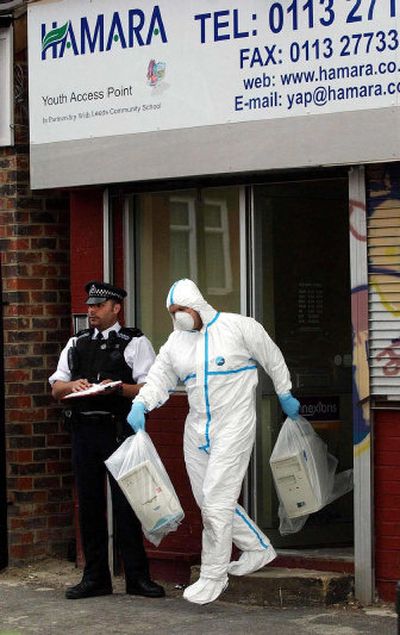Bombing investigators turn focus overseas

LONDON – The probe into the London suicide attacks shifted overseas Friday as officials in Cairo announced the arrest of a wanted biochemist and authorities searched for a Pakistani man suspected of helping in the plot and leaving the country the day before the bombings.
A separate search continued for a man whom a security videotape shows talking with the bombers in a train station the morning of the attacks, intelligence sources said.
A week into the highly secretive probe, investigators appeared to be theorizing a conspiracy of at least seven people – the four bombers plus these three possible accomplices.
Counterterrorism officials in that country confirmed Friday that two of the bombers visited Pakistan separately in the past year and apparently met with members of radical Islamic networks. Friends have said a third bomber also traveled to the country. These three of the four bombers were of Pakistani heritage.
“There is a Pakistan connection,” Ian Blair, head of the British police, told the BBC on Friday morning. “But what we expect to find at some stage is that there is a clear al Qaeda link because the four men who are dead are in the category of foot soldiers.”
The hunt for the man who spoke with the bombers began after British intelligence reviewed a surveillance video from Luton rail station north of London and saw the four attackers huddled in conversation with another man on the morning of the bombings, British and U.S. intelligence sources said Friday.
British intelligence has interviewed a witness who was at the station at the time, according to the sources, who could discuss intelligence matters only on condition of anonymity. The witness told authorities that when the conversation among the men ended, the four now identified as the bombers walked away together, while the other, still-unidentified man left alone in the opposite direction and boarded a train.
The Pakistani man who is being sought has not been identified. But two investigators say he entered Britain at an English Channel port two weeks before the July 7 subway and bus bombings and then left the country the day before the attacks, two investigators said.
The man had been on Britain’s terrorism watch list but was still allowed to enter the country. One of the officials said the suspect is one of a several foreign citizens whom investigators are seeking and cautioned against speculation that he was the mastermind of the July 7 attacks.
Blair confirmed that the suspect was not placed under surveillance when he came to Britain last month because he was not classified as a high risk. Other officials said investigators are still trying to determine whether the man had contact with the bombers while he was in the country.
One intelligence source cautioned that despite several promising leads, authorities are still not convinced the operation was planned or ordered from outside Britain. “Al Qaeda has sometimes used someone as an ignition key to set off an attack, but in this case, we don’t have that yet,” one source said.
Meanwhile, Pakistani intelligence and law enforcement agents questioned relatives and others who had contact with Shehzad Tanweer, 22, and Hasib Hussain, 18, during separate visits they made to the city of Lahore in the past year and found evidence that they had met with suspected militants, according to two senior Pakistani officials.
Tanweer’s relatives have said he left his home in Leeds for Lahore in December and intended to stay for nine months to study Arabic and the Quran, but returned several months early. Acquaintances in Leeds said Hussain also spent time in Pakistan last year.
Teachers at the religious school in the city of Muridke said Friday that Pakistani intelligence agents had visited them several times in the past five days to ask about Tanweer.
A senior police official in Lahore said radical groups are wary of making their presence felt at the madrassa because they know it is under police surveillance. “Smart networks like the one that executed the London operation wouldn’t send its assets for a longer stay” at a school such as the one in Muridke, the police official said.
In Cairo, Egyptian officials said they arrested Magdy Nashar, a biochemist at Leeds University who is wanted by British authorities for questioning in the attacks. Residents in Leeds said Nashar had helped in the rental of a Leeds townhouse near the university where police found explosives after a raid Tuesday. Officials said they suspect the townhouse was used to assemble the bombs used in London, although investigators said they are unsure whether Nashar was aware of the plot.
The family of Hussain, the 18-year-old bombing suspect, issued a public statement calling him “a loving and normal young man who gave us no concern.” The family said it was “devastated” by the attacks and taken aback by his involvement. “We had no knowledge of his activities and had we done, we would have done everything in our power to stop him.”
A major unresolved mystery centers on the kind of explosives used in the attacks. At first, police officials said each backpack carried by the bombers contained 10 pounds of what they called “high explosives” and said the devices were not “homemade.” On Friday, however, investigators gave a different description, saying that further investigation had revealed that the bombs probably consisted of publicly obtainable materials.
Officials said bomb disposal experts had found quantities of triacetone triperoxide, a highly volatile substance known as TATP, at one of the houses in Leeds.
Experts said the material, which can be found in drain cleaner and other commercial products, is similar to what Richard Reid, now serving a life sentence in the United States, used in trying to blow up an American Airlines flight in 2001. The explosives were concealed in his shoes.